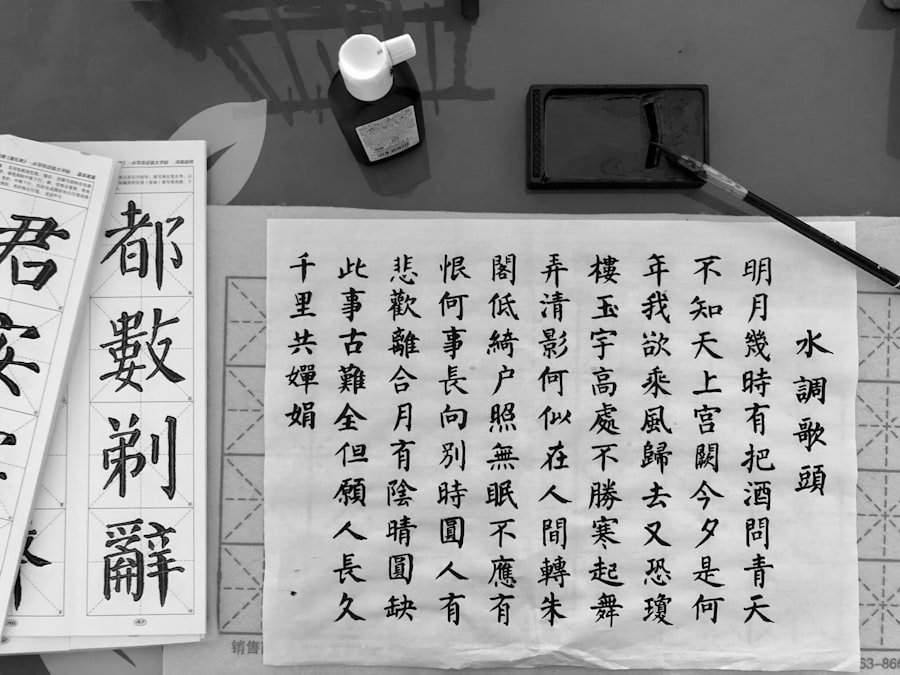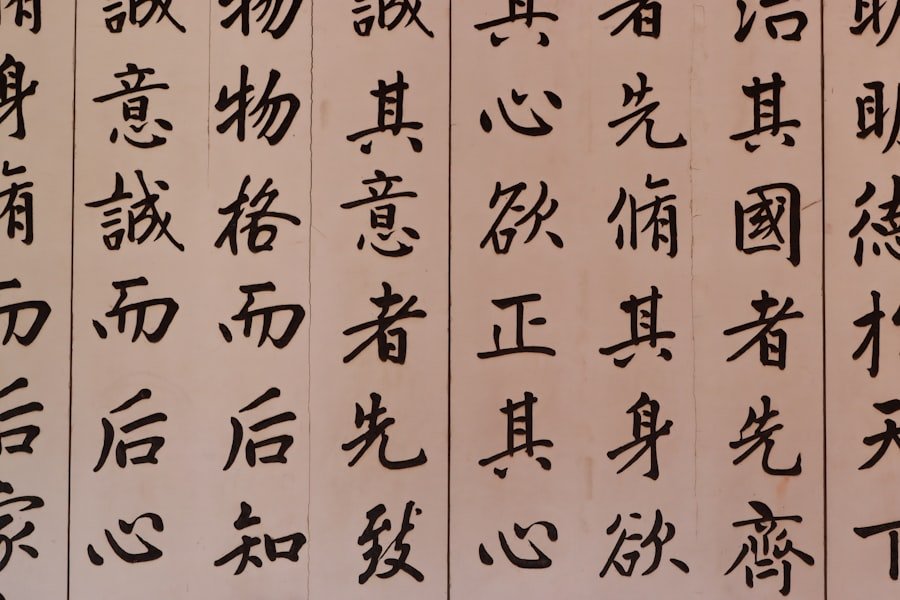The journey of Chinese characters is a fascinating tale that traces back thousands of years, rooted in the ancient practice of pictography. Initially, these characters emerged as simple drawings that represented objects, actions, or ideas. Over time, they evolved into a complex system of writing that encapsulates the rich tapestry of Chinese culture and history.
The earliest forms of Chinese writing, known as oracle bone script, were inscribed on animal bones and shells, primarily used for divination purposes. These characters were direct representations of the objects they depicted, making them easily recognisable to those who used them. As the centuries progressed, the characters underwent significant transformations.
The transition from pictographs to more abstract forms allowed for greater flexibility and complexity in expression. This evolution was not merely a change in form but also a reflection of the changing societal needs and cultural contexts. The introduction of ideographs and phonetic components added layers of meaning to the characters, enabling them to convey more nuanced concepts.
Thus, what began as simple images gradually morphed into a sophisticated writing system that continues to be a cornerstone of Chinese identity. Master the art of Chinese calligraphy. Enroll now at the LC Chinese School in Oslo.
Table of Contents
ToggleSummary
- Chinese characters have evolved from pictographs, which were simple drawings representing objects or ideas.
- Nature and everyday objects have heavily influenced the formation of Chinese characters, with many characters being derived from these sources.
- Pictographic writing has played a crucial role in preserving ancient Chinese culture and traditions.
- Pictographs convey not only meaning but also emotion, adding depth and complexity to Chinese characters.
- Pictographic Chinese characters are not only functional but also possess artistic and aesthetic elements, making them visually appealing.
The Influence of Nature and Everyday Objects on Chinese Characters
Nature has played an instrumental role in shaping the lexicon of Chinese characters. Many characters are derived from elements found in the natural world, reflecting the deep connection between the Chinese people and their environment. For instance, the character for “tree” (木) is a straightforward representation of a tree’s trunk and branches, while “mountain” (山) visually mimics the peaks of a mountain range.
This intrinsic link to nature not only illustrates the physical world but also embodies the philosophical principles that underpin Chinese culture, such as harmony and balance. Everyday objects also find their way into the formation of Chinese characters, further enriching the language. Characters like “house” (家) and “water” (水) are derived from common items that were integral to daily life in ancient China.
This connection to the mundane serves to ground the language in reality, making it accessible and relatable to its users. The incorporation of these elements into the writing system highlights how language evolves alongside human experience, capturing the essence of life as it unfolds.
The Role of Pictographic Writing in Preserving Ancient Chinese Culture

Pictographic writing has been pivotal in preserving ancient Chinese culture and traditions. The characters serve as vessels for historical narratives, cultural practices, and philosophical ideas that have been passed down through generations. By documenting rituals, beliefs, and societal norms, these characters have become a crucial link to the past, allowing contemporary society to connect with its heritage.
The continuity of this writing system has enabled scholars and historians to study ancient texts, providing insights into the lives and thoughts of those who came before. Moreover, the use of pictographs has fostered a sense of identity among Chinese people. The characters are not merely tools for communication; they embody cultural values and collective memory.
Each character carries with it a story, a lesson, or a piece of wisdom that reflects the ethos of Chinese civilisation. As such, learning these characters becomes an act of cultural preservation, allowing individuals to engage with their history while fostering a sense of belonging within a broader community.
How Pictographs Convey Meaning and Emotion in Chinese Characters
Pictographs possess an inherent ability to convey meaning and emotion through their visual representation. Unlike alphabetic systems that rely on phonetics, Chinese characters often encapsulate complex ideas within their structure. For example, the character for “love” (爱) combines elements that suggest both affection and connection, illustrating how emotions can be expressed through visual language.
This unique characteristic allows for a depth of expression that resonates with speakers on an emotional level. Furthermore, the aesthetic quality of pictographs enhances their communicative power. The fluidity and grace with which these characters are written can evoke feelings that go beyond mere words.
Calligraphy, as an art form, elevates this emotional expression by transforming writing into a visual spectacle. The strokes and curves employed by calligraphers can convey passion, serenity, or even turmoil, allowing for a rich interplay between language and emotion.
The Artistic and Aesthetic Elements of Pictographic Chinese Characters
The artistic dimension of pictographic Chinese characters is one of their most captivating aspects. Each character is not only a means of communication but also a work of art in its own right. The strokes that form these characters are imbued with rhythm and flow, reflecting the calligrapher’s personal style and emotional state at the moment of creation.
This interplay between art and language creates a unique aesthetic experience that transcends mere literacy. Calligraphy has long been revered in Chinese culture as a high art form, with practitioners dedicating years to mastering its techniques. The beauty of each character lies in its balance and proportion; even slight variations can alter its visual impact significantly.
This emphasis on aesthetics fosters an appreciation for the written word as an expression of beauty and creativity, encouraging individuals to engage with language on a deeper level.
The Symbolism and Cultural Significance of Pictographic Chinese Characters

Pictographic characters are steeped in symbolism, often representing more than their literal meanings. Each character can embody philosophical concepts or cultural beliefs that resonate deeply within Chinese society. For instance, the character for “fortune” (福) is often associated with prosperity and happiness, making it a popular symbol during celebrations such as the Lunar New Year.
This symbolic richness adds layers of meaning to everyday communication, allowing individuals to express complex ideas succinctly. Moreover, these characters serve as cultural markers that distinguish Chinese identity from other linguistic traditions. They encapsulate values such as respect for nature, familial bonds, and harmony within society.
As such, learning about these symbols provides insight into the collective psyche of the Chinese people, fostering cross-cultural understanding and appreciation.
Pictographic Chinese Characters in Modern Communication and Technology
In today’s digital age, pictographic Chinese characters continue to play a vital role in communication despite the rise of technology. While modern platforms may favour speed and efficiency over traditional forms of writing, the essence of pictographs remains relevant. Emojis and other visual symbols used in digital communication echo the principles of pictography by conveying emotions or ideas through images rather than words alone.
However, this evolution also presents challenges as younger generations increasingly rely on digital shortcuts rather than engaging with traditional characters. The risk is that this reliance may lead to a dilution of cultural heritage if not balanced with an appreciation for the depth and history embedded within these characters. Therefore, it is essential to promote awareness about the significance of pictographic writing in contemporary contexts while embracing technological advancements.
The Influence of Pictographic Writing on Chinese Calligraphy and Art
Pictographic writing has profoundly influenced Chinese calligraphy and art throughout history. Calligraphy is not merely about writing; it is an artistic expression that transforms words into visual masterpieces. The fluidity and grace inherent in pictographs lend themselves beautifully to calligraphic techniques, allowing artists to explore their creativity while honouring tradition.
The interplay between pictographs and calligraphy has given rise to various styles that reflect different historical periods and regional influences. From the bold strokes of seal script to the delicate lines of cursive script, each style tells a story about its time and place within Chinese culture. This artistic evolution showcases how pictographic writing continues to inspire creativity while preserving cultural heritage.
The Cognitive and Educational Benefits of Learning Pictographic Chinese Characters
Learning pictographic Chinese characters offers numerous cognitive benefits that extend beyond language acquisition. Engaging with these characters stimulates critical thinking skills as learners decipher meanings based on visual cues rather than phonetic sounds alone. This process encourages creativity and imagination as individuals explore connections between symbols and concepts.
Moreover, studying pictographs fosters cultural awareness and appreciation among learners. Understanding the historical context behind each character enriches one’s knowledge about Chinese culture while promoting cross-cultural dialogue. As students delve into this intricate writing system, they develop not only linguistic proficiency but also a deeper understanding of global diversity.
The Challenges and Advantages of Pictographic Chinese Characters in Language Learning
While learning pictographic Chinese characters presents unique advantages, it also comes with its share of challenges. One significant hurdle is memorisation; with thousands of characters to learn, students may feel overwhelmed by the sheer volume required for literacy. Unlike alphabetic systems where letters combine to form words, each character must be learned individually, which can be daunting for beginners.
However, this challenge can also be viewed as an opportunity for deeper engagement with language learning. The process encourages learners to develop patience and perseverance while fostering a sense of accomplishment as they master each character. Additionally, understanding the etymology behind each pictograph can enhance retention by creating meaningful connections between symbols and their meanings.
The Future of Pictographic Chinese Characters in a Globalized World
As we navigate an increasingly globalised world, the future of pictographic Chinese characters remains bright yet complex. While technology continues to shape communication methods, there is a growing recognition of the importance of preserving cultural heritage amidst rapid change. Educational institutions worldwide are beginning to incorporate lessons on traditional writing systems into their curricula, fostering appreciation for diverse linguistic traditions.
In this context, institutions like LC Chinese School in Oslo play a crucial role in promoting understanding and appreciation for Chinese calligraphy through dedicated courses focused on this art form. These classes not only teach students how to write characters but also delve into their historical significance and aesthetic qualities. By engaging with calligraphy at LC Chinese School, learners can connect with their cultural roots while developing skills that transcend language barriers.
In conclusion, pictographic Chinese characters are more than mere symbols; they are living embodiments of culture, history, and artistic expression. As we move forward into an ever-evolving world, it is essential to embrace both tradition and innovation while fostering appreciation for this remarkable writing system that continues to shape identities across generations.
Master the art of Chinese calligraphy. Enroll now at the LC Chinese School in Oslo.







